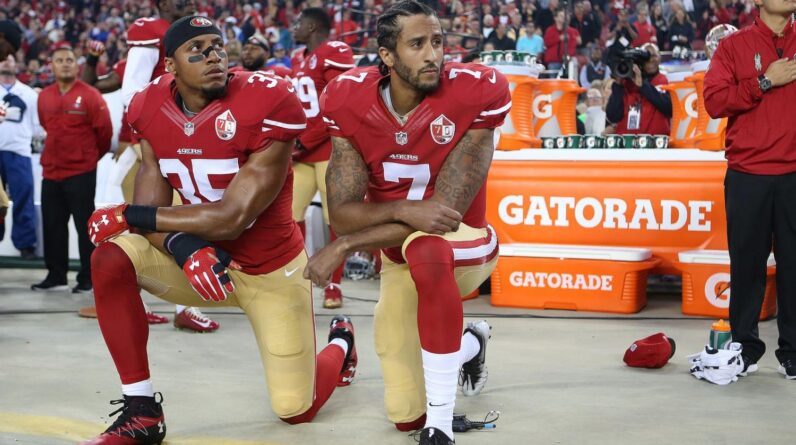
Kneeling to the National Anthem is seen as disrespectful as it is viewed as a sign of protest against the country and its values. When it comes to the act of kneeling during the National Anthem, opinions are divided.
While some argue that it is a peaceful form of protest to bring attention to social injustices, others believe that it is disrespectful to the nation and its symbols. The act of kneeling during the anthem gained attention in recent years when professional athletes began doing so to protest against racial inequality and police brutality.
Those who view it as disrespectful argue that it undermines the sacrifices made by veterans and disrespects the flag, which is a symbol of the nation’s unity and freedom. This controversy surrounding kneeling during the National Anthem highlights the ongoing debate about the appropriate way to express dissent and discuss important societal issues.
1. The Significance Of The National Anthem
The national anthem holds great significance, both historically and symbolically. Understanding this significance helps shed light on why some individuals view kneeling during its rendition as disrespectful. From a historical context, the national anthem represents the unity and patriotism of a nation, symbolizing the values and sacrifices of its people.
It honours the struggles and accomplishments that have shaped the country. The symbolism of the national anthem lies in its ability to evoke a sense of pride, respect, and gratitude for the ideals and freedoms it represents. Therefore, when individuals choose to kneel during the national anthem, they are expressing a form of protest that deviates from the traditional show of reverence.
This action sparks debate and controversy, as it challenges prevailing social norms and expectations surrounding national symbols. The varying perspectives on this issue highlight the ongoing dialogue about the role of dissent and peaceful protest in a democratic society.
1.1. The Meaning Behind The National Anthem
The act of kneeling during the National Anthem has sparked debates about its perceived disrespect. The National Anthem is a symbol of unity and pride for many, representing the values and history of a nation. The lyrics of the anthem, with phrases like “land of the free” and “home of the brave”, evoke a sense of patriotism and honour. However, differing interpretations of these lyrics and their representation can lead to varying perspectives on what it means to kneel during its performance.
Some argue that kneeling is a form of peaceful protest against social injustices and inequality. By taking a knee, individuals aim to bring attention to issues that they believe still hinder true liberty and justice for all. This act is seen by some as a solemn call for change, rooted in their love and desire to improve their nation.
However, those who see kneeling as disrespectful argue that it undermines the sacrifices made by armed forces and disrespects the principles that the National Anthem upholds. They believe that standing during the anthem is a way to honour those who have fought for the country’s freedom and unity.
1.2. The Purpose Of The National Anthem
When the national anthem is played, it serves a dual purpose of unifying the nation and celebrating our national identity. It symbolizes our shared values, history, and sacrifices of those who have fought for our freedom. While standing and showing respect during the national anthem has been the convention, recently there has been a more visible form of protest – kneeling. This act, initiated to draw attention to social issues, has sparked debates about its perceived disrespect towards the flag and our country.
| Pros of Kneeling | Cons of Kneeling |
|---|---|
| Kneeling highlights the need for equality and justice for all. | Kneeling can be seen as a direct defiance of patriotic traditions and disrespectful towards the armed forces. |
| It represents the freedom of expression guaranteed by the First Amendment. | It can be interpreted as a sign of disrespect towards the national anthem and the nation as a whole. |
| Kneeling fosters dialogue and promotes awareness about social injustices. | Kneeling can create division and detract from the intended purpose of the national anthem. |
While opinions on kneeling during the national anthem may differ, it is essential to recognize the underlying intention behind this form of protest. Kneeling serves as a powerful tool to draw attention to societal issues and aims to prompt discussions that can lead to positive change. The ongoing debate highlights the importance of respecting differing viewpoints while striving to find common ground.
2. The Controversy Surrounding Kneeling
Introduction to the kneeling gesture
The act of kneeling during the national anthem has ignited a heated debate and divided public opinion. Its origin can be traced back to 2016 when NFL player Colin Kaepernick first took a knee to protest against racial inequality and police brutality.
The gesture was intended to raise awareness and prompt a national conversation about systemic racism. However, many critics argue that kneeling during the national anthem is disrespectful to the flag and the sacrifices made by those who fought for the country’s freedom.
The public perception of kneeling during the national anthem varies greatly. Some view it as a powerful display of peaceful protest and a way to challenge ingrained societal issues. Others interpret it as a direct affront to the nation, its values, and the military.
The controversy surrounding the kneeling gesture highlights the deep divisions within society and the ongoing struggle to find common ground on issues of race, patriotism, and freedom of speech.
2.1. Proponents’ Perspective
Kneeling during the national anthem has been seen by some as disrespectful, particularly within the context of sports events. Proponents of kneeling argue that it serves as a peaceful form of protest against social injustice and raises awareness of racial inequality. By taking a knee, athletes aim to draw attention to systemic problems within society and inspire dialogue and change.
| Proponents’ Perspective |
|---|
| Kneeling as a peaceful form of protest |
| Raising awareness of racial inequality |
2.2. Opponents’ Perspective
Kneeling during the national anthem has been perceived by opponents as disrespectful towards the flag and country. This act has been interpreted as a disregard for the sacrifices made by the military. Critics argue that by kneeling, individuals are showing a lack of patriotism and failing to honour the values and principles the flag represents.
The opponents strongly believe that the national anthem is a symbol of unity, freedom, and the hard-fought rights and liberties that the country upholds. From their perspective, kneeling during the anthem undermines these values and displays a form of disrespect that is deeply offensive.
This viewpoint is often associated with the emotional connection people have with the anthem and the flag, leading them to view any deviation from traditional behaviour as a direct affront to the nation.
3. Dissecting The Disrespect Argument
Analyzing the nature of respect and its subjective interpretation is crucial in understanding why kneeling during the national anthem is considered disrespectful. Respect is a deeply personal and subjective feeling that can differ from person to person.
This means that what may be respectful to one individual may not be seen the same way by another. In the case of kneeling during the national anthem, some argue that it disrespects the flag, the country, and its values. However, it’s important to recognize that the act of kneeling is a peaceful protest against systemic racial injustice and police brutality.
While some may interpret it as disrespectful, it is essential to acknowledge the intentions behind the action. These intentions aim to spark dialogue, raise awareness, and promote positive social change. Respect, therefore, should encompass a comprehensive understanding of different perspectives and the recognition of the importance of peaceful expression for societal progress.
3.1. Freedom Of Expression And Protest
The act of kneeling during the national anthem has sparked controversy as it is perceived by some as disrespectful. However, it is important to understand that this form of protest is rooted in the concept of freedom of expression, which is protected by the Constitution. Constitutional rights grant individuals the ability to peacefully voice their concerns and frustrations, even if it may be deemed controversial.
This raises the question of balancing patriotism and personal beliefs. While the national anthem symbolizes unity, it is crucial to respect the diverse perspectives and individual opinions that comprise a democratic society. These peaceful protests aim to draw attention to social injustices and spark conversations that lead to positive change.
In conclusion, it is essential to recognize that kneeling during the national anthem is a form of peaceful protest protected by constitutional rights. Although controversial, it allows individuals to exercise their freedom of expression and address social issues that require attention.
3.2. Separating Criticism From Disrespect
Kneeling during the national anthem has been a point of controversy and debate. It is important to distinguish between critique and disrespect when discussing this act. While some argue that kneeling is disrespectful towards the nation and its symbols, others see it as a form of peaceful protest expressing concerns about social injustice. Respectful alternatives to protesting during the national anthem can include raising a fist, linking arms, or staying seated.
Criticism can be an act of raising awareness and calling for change. It is essential to separate criticism from outright disrespect. It is possible to voice concerns without undermining the importance of national symbols and values.
By engaging in constructive dialogue and understanding differing perspectives, it is possible to find common ground and work towards a more inclusive and respectful society. Respectful actions during the national anthem can convey the message effectively without causing offence or disrespect.

Credit: www.nytimes.com
Frequently Asked Questions Of Why Is Kneeling To The National Anthem Disrespectful
Why Do Some People Consider Kneeling To The National Anthem Disrespectful?
Some people consider kneeling during the national anthem disrespectful because they believe it undermines the values and sacrifices represented by the anthem. It is seen as a sign of protest against the country and its institutions, particularly in relation to perceived issues of injustice and inequality.
However, others argue that kneeling is a peaceful way to raise awareness of these issues and provoke dialogue for positive change.
Is Kneeling During The National Anthem A Form Of Protest?
Yes, kneeling during the national anthem is a form of peaceful protest. It was popularized by athletes to draw attention to social injustices and systemic racism. By taking a knee, individuals aim to raise awareness about issues and spark conversation for change.
Despite the controversy, it remains a symbol of unity and a call for equality.
Can Kneeling During The National Anthem Be Seen As Unpatriotic?
Some people view kneeling during the national anthem as unpatriotic because it can be seen as a form of protest against the country and its institutions. However, others argue that it is a patriotic act as it highlights the importance of free speech and the pursuit of social justice, which are integral to the values upon which the nation was built.
Ultimately, the perception of patriotism may vary among individuals and their beliefs.
Conclusion
In short, kneeling during the national anthem is seen by many as disrespectful because it goes against the long-standing tradition of standing to honour the flag and the country it represents. While some argue that it is a peaceful form of protest, it is important to remember that actions can be interpreted differently by different people.
Ultimately, it is up to each individual to decide how they choose to show their support or dissent.




